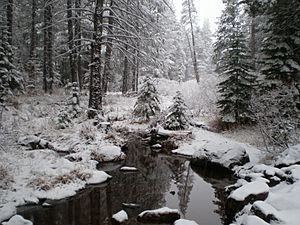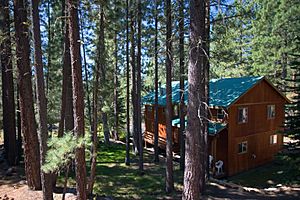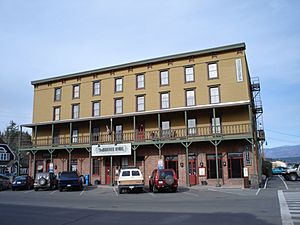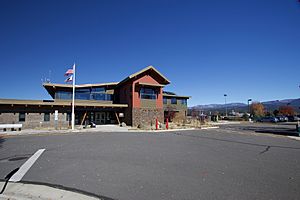Truckee, California facts for kids
Quick facts for kids
Truckee
|
|||
|---|---|---|---|

Donner Pass Road
|
|||
|
|||
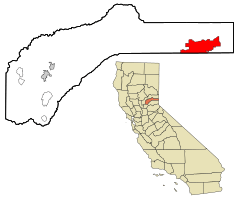
Location in Nevada County in the state of California
|
|||
| Country | United States | ||
| State | California | ||
| County | Nevada | ||
| Incorporated | March 23, 1993 | ||
| Named for | Truckee | ||
| Area | |||
| • Total | 33.66 sq mi (87.19 km2) | ||
| • Land | 32.33 sq mi (83.74 km2) | ||
| • Water | 1.33 sq mi (3.45 km2) 3.96% | ||
| Elevation | 6,152 ft (1,875 m) | ||
| Population
(2020)
|
|||
| • Total | 16,729 | ||
| • Density | 517.6/sq mi (199.84/km2) | ||
| Time zone | UTC−8 (Pacific) | ||
| • Summer (DST) | UTC−7 (PDT) | ||
| ZIP Codes |
96160–96162
|
||
| Area code | 530 | ||
| FIPS code | 06-80588 | ||
| GNIS feature IDs | 2413403 | ||
Truckee is an incorporated town in Nevada County, California, United States. As of the 2010 United States Census, the population was 16,180, reflecting an increase of 2,316 from the 13,864 counted in the 2000 Census.
Contents
History
Name
Truckee's existence began in 1863 as Gray's Station, named for Joseph Gray's Roadhouse on the trans-Sierra wagon road. A blacksmith named Samuel S. Coburn was there almost from the beginning, and by 1866 the area was known as Coburn's Station. The Central Pacific Railroad selected Truckee as the name of its railroad station by August 1867, even though the tracks would not reach the station until a year later in 1868. It was renamed Truckee after a Paiute chief, whose assumed Paiute name was Tru-ki-zo. He was the father of Chief Winnemucca and grandfather of Sarah Winnemucca. The first Europeans who came to cross the Sierra Nevada encountered his tribe. The friendly chief rode toward them yelling, “Tro-kay!”, which is Paiute for 'Everything is all right'. The unaware travelers assumed he was yelling his name. Chief Truckee later served as a guide for John C. Frémont.
Donner Party
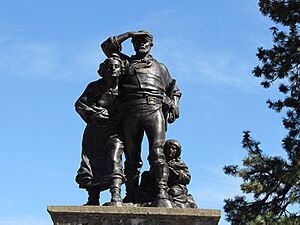
The Donner Party ordeal is arguably Truckee's most famous historical event. In 1846, a group of settlers from Illinois, originally known as the Donner-Reed Party but now usually referred to as the Donner Party, became snowbound in early fall as a result of several trail mishaps, poor decision-making, and an early onset of winter that year. Choosing multiple times to take shortcuts to save distance compared to the traditional Oregon Trail, coupled with infighting, a disastrous crossing of the Utah salt flats, and the attempt to use the pass near the Truckee River (now Donner Pass) all caused delays in their journey.

Finally, a large, early blizzard brought the remaining settlers to a halt at the edge of what is now Donner Lake, about 1,200 feet (370 m) below the steep granite summit of the Sierra Nevada mountains and 90 miles (140 km) east of their final destination, Sutter's Fort (near Sacramento). Several attempts at carting their few remaining wagons, oxen, and supplies over the summit—sometimes by pulling them up by rope—proved impossible due to freezing conditions and a lack of any preexisting trail. The party returned, broken in spirit and short of supplies, to the edge of Donner Lake. A portion of the camp members also returned to the Alder Creek campsite a few miles to the east.
During the hard winter the travelers endured starvation and were later found to have practiced cannibalism. Fifteen members constructed makeshift snowshoes and set out for Sutter's Fort in the late fall but were thwarted by freezing weather and disorientation. Only seven survived: two were lost, and six died. Those who died were used as food by those who remained. The Truckee camp survivors were saved by a Reed Party member who had set out ahead after having been ejected from the party months earlier for killing another man in a violent argument. Seeing that the group never arrived at Sutter's Fort, he initiated several relief parties.
Of the original 87 settlers in the Donner-Reed party, 48 survived the ordeal. The Donner Memorial State Park is dedicated to the settlers and is located at the East End of Donner Lake.
Historical events
Truckee grew as a railroad town originally named Coburn Station, starting with the Transcontinental Railroad. The railroad goes into downtown Truckee, and the Amtrak passenger lines still stop there on the trip from Chicago to San Francisco.
Truckee's Sinophobic movement had begun during the Reconstruction Period, marked by the Trout Creek Outrage of 1876:
By 1876, some 300 of the town’s residents, from workers to its most prominent citizens, had formed a local chapter of the Order of the Caucasians, also known as the Caucasian League, to drive out the Chinese. Truckee gained statewide notoriety that summer when late one night seven of the group's members, clad in black, surrounded and set fire to two cabins full of Chinese woodcutters who had refused to leave the area. The vigilantes shot at the Chinese men as they ran out of the cabin, killing forty-five-year-old Ah Ling.
Charles Fayette McGlashan, local lawyer and owner/publisher of the Truckee Republican, defended those accused in the Trout Creek Outrage and was a leader in the town's anti-Chinese movement. In 1886, the town's Chinese inhabitants, about 1,400 in number, were expelled from Truckee as part of a campaign that included a boycott of any business that did business with Chinese.
In 1891, lawman Jacob Teeter was killed in a violent gunfight with fellow lawman, James Reed (no relation to James Frazier Reed of the Donner Party). Constable Reed was among those accused of participating in the Trout Creek Outrage fifteen years prior.
Truckee reportedly had one of the nation's first mechanized ski lifts at the site of the Hilltop Lodge. The historic Hilltop Lodge was converted to a restaurant in the 1940s by the Crandall Brothers, and eventually became Cottonwood Restaurant and Bar. There were possibly two rope tows and a Poma lift, which was installed in 1954. At the same location there was a ski jump constructed during the early 1900s that was designed by Lars Haugen, a seven-time Olympic ski jumping champion.
In 1993, Truckee incorporated as a city.
Geography
According to the United States Census Bureau, the town has a total area of 33.7 square miles (87 km2), of which 32.3 square miles (84 km2) is land and 1.3 square miles (3.4 km2) (3.96%) is water, mostly Donner Lake and the Truckee River.
Climate
Under the Köppen climate classification system, Truckee has a humid continental climate (Dsb) with Mediterranean like characteristics. Winters are chilly with regular snowfall, while summers are warm to hot and dry, with occasional periods of intense thunderstorms. Its location near the Sierra Nevada crest at 1,798 metres (5,899 ft) provides conditions for winter storms to commonly deposit nearly a meter of snow in a 24-hour storm event and the occasional week-long storm event can deliver 2 to 3 metres (79 to 118 in) of snow. The National Weather Service reports that Truckee's warmest month is July with an average maximum temperature of 82.7 °F (28.2 °C) and an average minimum temperature of 42.4 °F (5.8 °C). January is the coldest month with an average maximum temperature of 40.9 °F (4.9 °C) and an average minimum temperature of 16.3 °F (−8.7 °C). The record maximum temperature of 101 °F (40 °C) was on August 28, 1915. The record minimum temperature of −28 °F (−33.3 °C) was on February 27, 1962. Annually, there are an average of 8.4 days with highs of 90 °F (32.2 °C) or higher and 239 with a high above 50 °F (10 °C). Freezing temperatures have been observed in every month of the year and there are an average of 228.4 nights with lows of 32 °F (0 °C) or lower – seven more than Fairbanks and only eight fewer than Nome – but only 6.0 nights with lows of 0 °F (−17.8 °C) or lower and 15.6 days where the high does not top freezing.
Normal annual precipitation in Truckee is 30.85 inches (783.6 mm); measurable precipitation (0.01 inches (0.25 mm) or more) occurs on an average of 87.0 days annually. The most precipitation in one month was 23.65 inches (600.7 mm) in December 1955, and the most precipitation in 24 hours was 5.21 inches (132.3 mm) on February 1, 1963. The wettest calendar year has been 1997 with 54.62 inches (1,387.3 mm) and the driest 1976 with 16.04 inches (407 mm), although the extremes by “rain year” are a maximum of 53.50 inches (1,358.9 mm) between July 1981 and June 1982 and a low of 15.91 inches (404.1 mm) between July 2000 and June 2001.
Truckee has an average of 206.6 inches (5.25 m) of snow annually, which makes it the fifth-snowiest city in the United States, while snow cover usually averages 28 inches (0.71 m) in February, but has exceeded 115 inches (2.92 m). The most snow in one month was 196.0 inches (4.98 m) in February 1938, and the most in a season was 444.30 inches (11.29 m) between July 1951 and June 1952. The maximum 24-hour snowfall was 34.0 inches (0.86 m) on February 17, 1990.
| Climate data for Truckee, California (Truckee Ranger Station), 1991–2020 normals, extremes 1904–2009 | |||||||||||||
|---|---|---|---|---|---|---|---|---|---|---|---|---|---|
| Month | Jan | Feb | Mar | Apr | May | Jun | Jul | Aug | Sep | Oct | Nov | Dec | Year |
| Record high °F (°C) | 64 (18) |
68 (20) |
73 (23) |
83 (28) |
92 (33) |
94 (34) |
100 (38) |
101 (38) |
95 (35) |
87 (31) |
82 (28) |
66 (19) |
101 (38) |
| Mean maximum °F (°C) | 52.9 (11.6) |
55.0 (12.8) |
60.6 (15.9) |
68.9 (20.5) |
78.8 (26.0) |
86.8 (30.4) |
91.9 (33.3) |
91.1 (32.8) |
86.2 (30.1) |
77.7 (25.4) |
65.9 (18.8) |
55.0 (12.8) |
94.1 (34.5) |
| Mean daily maximum °F (°C) | 41.8 (5.4) |
44.5 (6.9) |
49.6 (9.8) |
54.8 (12.7) |
64.3 (17.9) |
74.8 (23.8) |
83.8 (28.8) |
83.8 (28.8) |
76.2 (24.6) |
64.6 (18.1) |
50.9 (10.5) |
40.5 (4.7) |
60.8 (16.0) |
| Daily mean °F (°C) | 28.8 (−1.8) |
29.9 (−1.2) |
35.4 (1.9) |
40.0 (4.4) |
47.8 (8.8) |
55.3 (12.9) |
62.6 (17.0) |
62.1 (16.7) |
55.2 (12.9) |
46.0 (7.8) |
36.0 (2.2) |
27.8 (−2.3) |
43.9 (6.6) |
| Mean daily minimum °F (°C) | 15.9 (−8.9) |
17.3 (−8.2) |
21.2 (−6.0) |
25.2 (−3.8) |
31.4 (−0.3) |
35.8 (2.1) |
41.4 (5.2) |
40.3 (4.6) |
34.1 (1.2) |
27.5 (−2.5) |
21.2 (−6.0) |
15.0 (−9.4) |
27.2 (−2.7) |
| Mean minimum °F (°C) | −4.1 (−20.1) |
−1.7 (−18.7) |
4.5 (−15.3) |
14.7 (−9.6) |
22.2 (−5.4) |
27.2 (−2.7) |
31.9 (−0.1) |
31.2 (−0.4) |
25.9 (−3.4) |
18.9 (−7.3) |
7.2 (−13.8) |
−0.9 (−18.3) |
−8.9 (−22.7) |
| Record low °F (°C) | −28 (−33) |
−23 (−31) |
−18 (−28) |
−1 (−18) |
6 (−14) |
18 (−8) |
15 (−9) |
20 (−7) |
16 (−9) |
4 (−16) |
−14 (−26) |
−30 (−34) |
−30 (−34) |
| Average precipitation inches (mm) | 5.68 (144) |
5.09 (129) |
4.46 (113) |
2.13 (54) |
1.49 (38) |
0.57 (14) |
0.26 (6.6) |
0.53 (13) |
0.63 (16) |
1.77 (45) |
2.81 (71) |
5.15 (131) |
30.57 (774.6) |
| Average snowfall inches (cm) | 43.6 (111) |
47.9 (122) |
34.2 (87) |
17.5 (44) |
4.1 (10) |
0.9 (2.3) |
0.0 (0.0) |
0.0 (0.0) |
0.5 (1.3) |
2.8 (7.1) |
14.9 (38) |
44.2 (112) |
210.6 (534.7) |
| Average extreme snow depth inches (cm) | 35 (89) |
42 (110) |
38 (97) |
20 (51) |
4 (10) |
0 (0) |
0 (0) |
0 (0) |
0 (0) |
2 (5.1) |
10 (25) |
25 (64) |
60 (150) |
| Average precipitation days (≥ 0.01 in) | 11.9 | 11.0 | 10.0 | 9.4 | 7.3 | 3.2 | 1.9 | 2.0 | 2.8 | 4.9 | 7.7 | 11.6 | 83.7 |
| Average snowy days (≥ 0.1 in) | 8.7 | 8.1 | 7.2 | 5.1 | 1.6 | 0.3 | 0.0 | 0.0 | 0.2 | 1.2 | 4.2 | 7.8 | 44.4 |
| Source 1: NOAA | |||||||||||||
| Source 2: WRCC (mean maxima and minima 1904–2009) | |||||||||||||
Demographics
| Historical population | |||
|---|---|---|---|
| Census | Pop. | %± | |
| 1880 | 1,147 | — | |
| 1890 | 1,350 | 17.7% | |
| 1970 | 1,392 | — | |
| 1980 | 2,389 | 71.6% | |
| 1990 | 3,484 | 45.8% | |
| 2000 | 13,864 | 297.9% | |
| 2010 | 16,180 | 16.7% | |
| 2020 | 16,729 | 3.4% | |
| 2023 (est.) | 17,039 | 5.3% | |
| U.S. Decennial Census | |||
2020
The 2020 US Census reported that Truckee had a population of 16,729. According to the Census, the breakdown of the town's population by race and ethnicity in 2020 was: 12,946 (77.4%) White, 3,128 (18.7%) Hispanic or Latino, 31 (0.2%) African American, 92 (0.5%) Native American, 275 (1.6%) Asian, 9 (0.1%) Native Hawaiian or Pacific Islander, 1,446 (8.8%) other races, and 1,930 (11.5%) from two or more races.
Per the 2021 American Community Survey, 50.3% of residents were male and 49.7% were female. 22.2% of residents were under 18, 15.9% were 65 or older, and the median age was 41.9 years. 8.1% of the town's population were people with disabilities.
There were 6,247 households, out of which 59.7% were married-couple family households, 18.8% had a male householder with no spouse present, and 12.5% had a female householder with no spouse present. The average family size was 3.07.
There were 13,374 housing units, of which 49.4% were reported as vacant and 50.6% were reported as occupied.
12.8% of Truckee residents had moved: 4.1% of Truckee residents had moved within the same county, 5.2% had moved from a different county within California, 1.1% had moved from a different state, and 2.4% had moved from abroad.
2010
The 2010 United States Census reported that Truckee had a population of 16,180. The population density was 480.8 inhabitants per square mile (185.6/km2). The racial makeup of Truckee was 13,992 (86.5%) White, 3,016 (18.6%) Hispanic or Latino, 60 (0.4%) African American, 95 (0.6%) Native American, 241 (1.5%) Asian, 15 (0.1%) Pacific Islander, 1,431 (8.8%) from other races, and 346 (2.1%) from two or more races.
The Census reported that 16,137 people (99.7% of the population) lived in households, 43 (0.3%) lived in non-institutionalized group quarters, and 0 (0%) were institutionalized.
There were 6,343 households, out of which 2,135 (33.7%) had children under the age of 18 living in them, 3,443 (54.3%) were opposite-sex married couples living together, 411 (6.5%) had a female householder with no husband present, 314 (5.0%) had a male householder with no wife present. There were 502 (7.9%) unmarried opposite-sex partnerships, and 43 (0.7%) same-sex married couples or partnerships. 1,382 households (21.8%) were made up of individuals, and 275 (4.3%) had someone living alone who was 65 years of age or older. The average household size was 2.54. There were 4,168 families (65.7% of all households); the average family size was 2.98.
The population was spread out, with 3,769 people (23.3%) under the age of 18, 1,139 people (7.0%) aged 18 to 24, 5,030 people (31.1%) aged 25 to 44, 4,986 people (30.8%) aged 45 to 64, and 1,256 people (7.8%) who were 65 years of age or older. The median age was 38.0 years. For every 100 females, there were 108.9 males. For every 100 females age 18 and over, there were 111.3 males.
There were 12,803 housing units at an average density of 380.4 per square mile (146.9/km2), of which 4,326 (68.2%) were owner-occupied, and 2,017 (31.8%) were occupied by renters. The homeowner vacancy rate was 3.3%; the rental vacancy rate was 7.8%. 10,783 people (66.6% of the population) lived in owner-occupied housing units and 5,354 people (33.1%) lived in rental housing units.
2000
As of the census of 2000, there were 13,864 people, 5,149 households, and 3,563 families residing in the town. The population density was 426.1 inhabitants per square mile (164.5/km2). There were 9,757 housing units at an average density of 299.8 per square mile (115.8/km2). The racial makeup of the town was 88.4% White, 0.3% African American, 0.6% Native American, 0.9% Asian, 0.2% Pacific Islander, 7.6% from other races, and 2.2% from two or more races. Hispanic or Latino of any race were 12.8% of the population.
There were 5,149 households, out of which 37.1% had children under the age of 18 living with them, 58.2% were married couples living together, 6.7% had a female householder with no husband present, and 30.8% were non-families. 18.7% of all households were made up of individuals, and 3.2% had someone living alone who was 65 years of age or older. The average household size was 2.68 and the average family size was 3.09.
In the town, the population was spread out, with 26.7% under the age of 18, 7.0% from 18 to 24, 36.8% from 25 to 44, 24.0% from 45 to 64, and 5.5% who were 65 years of age or older. The median age was 35 years. For every 100 females, there were 112.1 males. For every 100 females age 18 and over, there were 112.0 males.
The median income for a household in the town was $58,848, and the median income for a family was $62,746. Males had a median income of $38,631 versus $29,536 for females. The per capita income for the town was $26,786. About 2.8% of families and 4.6% of the population were below the poverty line, including 5.3% of those under age 18 and 2.0% of those age 65 or over. Recent land clearing outside town limits may affect the population.
Education
The Tahoe-Truckee Unified School District provides K-12 education to Truckee and the Lake Tahoe area with six schools in the town itself. These consist of two elementary schools, one elementary-middle school, one middle school, and two high schools including Truckee High School.
Infrastructure
Transportation
Amtrak's California Zephyr stops daily at Truckee station.
A free public bus, operated by Placer County, California, connects Truckee station to Lake Tahoe, and to Incline Village, Nevada.
Greyhound operates from Truckee station.
Interstate 80 passes through Truckee.
Truckee-Tahoe Airport provides general aviation.
Notable people
- Krista Benjamin, poet and writer
- Alissa Bjerkhoel, litigation coordinator, California Innocence Project
- Win Butler, Canadian-American singer, songwriter, musician, and multi-instrumentalist
- Stacey Cook, World Cup alpine ski racer
- Kathleen Eagan, former mayor of Truckee
- Andy Finch, snowboarder
- Travis Ganong, World Cup alpine ski racer
- Chas Guldemond, snowboarder
- Jeff Hamilton, former World Speed Skiing champion, 1992 Olympic Bronze Medal winner
- Peter Johnson, former World Mogul Skiing champion
- Jeremy Jones, snowboarder
- Neel Kashkari, banker and politician
- Errol Kerr, downhill skier
- Ximena McGlashan, entomologist
- Debbie Meyer, former competition swimmer
- Ryan O'Nan, actor
- Daron Rahlves, a former World Skiing champion and Olympian
- Pierre Robert, rock music personality, WMMR in Philadelphia
- Karly Shorr, snowboarder
- April Stewart, voice actress
- Marco Sullivan, former World Cup alpine ski racer
- Annika Taylor, cross country skier
- Amy Westervelt, journalist
- Maia Wilkins, ballerina
See also
 In Spanish: Truckee para niños
In Spanish: Truckee para niños



